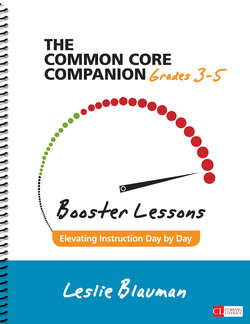Читать книгу The Common Core Companion: Booster Lessons, Grades 3-5 - Leslie Blauman - Страница 36
На сайте Литреса книга снята с продажи.
The Lesson
ОглавлениеT: Now we’re going to switch gears and instead of reading like readers, we’re going to read like writers. We’ve been talking about point of view in the texts we read and we’ve been discussing author’s intent. Well, when we write, we’re the author, so now we get to share our point of view. We actually are also trying to get others to see things as we do. And how do we get them to consider our take? We provide reasons for why we believe something about our topic, and we back up our reasons with facts and details. This is called writing an opinion piece. Sometimes we call this kind of writing persuasive because we’re attempting to persuade our reader to think the way we do. Have you ever tried to convince someone of something?
At this point, students will be clamoring to share their examples. Either choose a few or have students turn and talk so everyone gets a chance to be heard. Don’t let this become the main point of the lesson—keep it to a few minutes, tops!
T: I’ve brought an example of a persuasive text. Your job or purpose as I read it aloud is to think about what the author wants to persuade others to do or think.
Read the piece you’ve selected. I love to start withI Wanna New Room by Karen Kaufman Orloff (2010), or The Day the Crayons Quit by Drew Daywalt (2013); however, any persuasive or opinion text that is highly engaging and you know your students will enjoy is perfect.
Venn diagrams representing both the reading and writing. One is for the two fairy tales. The second compares and contrasts two books on POV.
After reading the text aloud, have students turn and talk with their partners, exploring these questions: What is the character trying to do? How does he or she do this? How does he or she support it—what reasoning is given?
Share student thinking as a whole group and begin to discuss how opinion writing is different from narrative and informative or explanatory texts. Record on chart paper. However, while opinion writing is its own standard, opinion and persuasion are often found in narratives and informative and explanatory texts.
Also, start an anchor chart of “Types of Opinion or Persuasive Writing.” Begin with the type you just read to the students and then model or brainstorm a few more. Have students work independently, continuing to brainstorm examples of opinion writing that they see in the real world, recording their thinking in their writer’s notebooks.
After 5 minutes, share ideas from their lists, either whole class, small group, or with partners. Challenge students to add to this list and to look for examples in their world and bring these in as mentor texts. The important thing to remember, though, is to have the kids do the work—let them search and notice! Students will be contributing to a class set of opinion writing samples that will turn into mentor texts.
